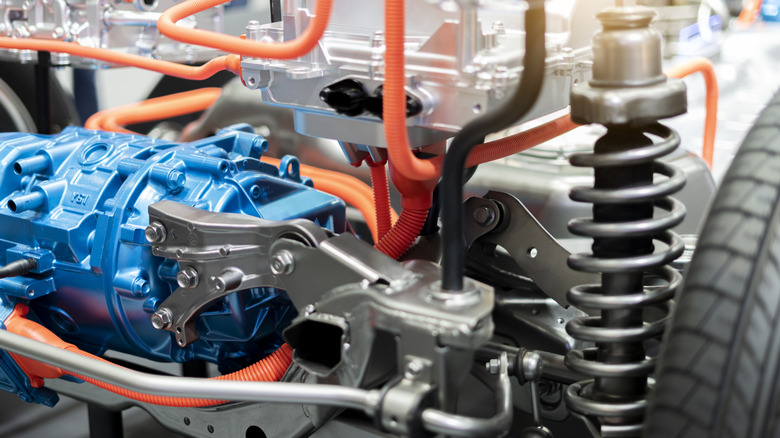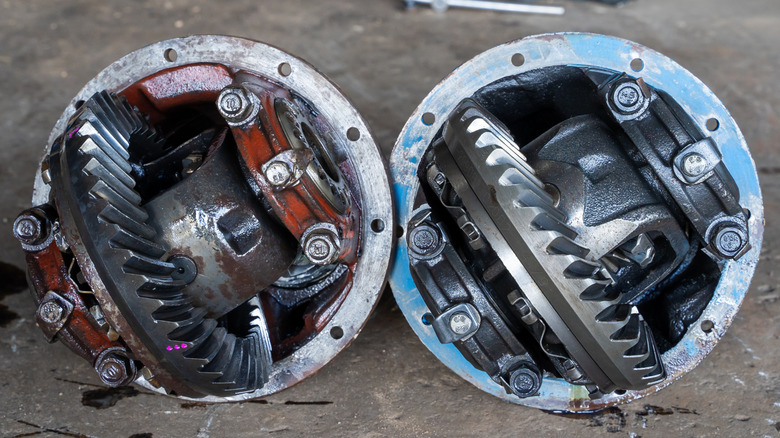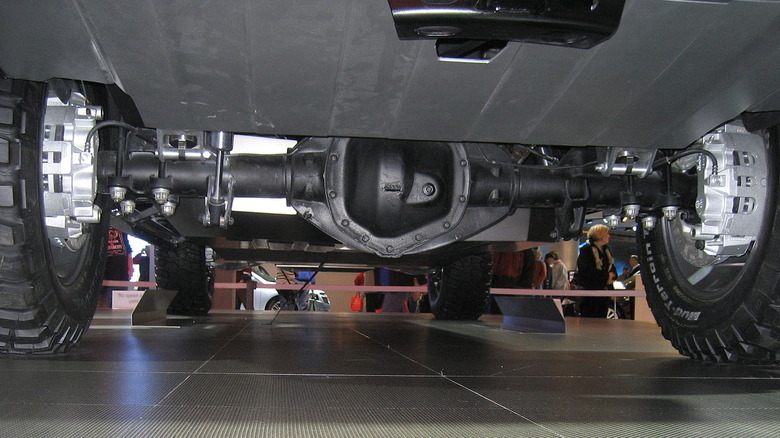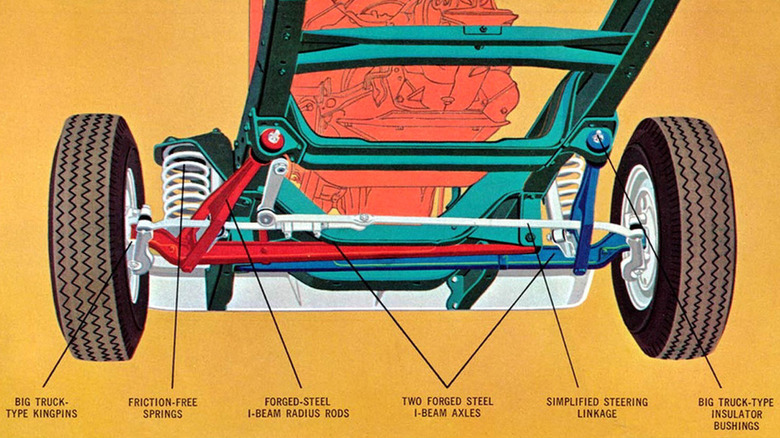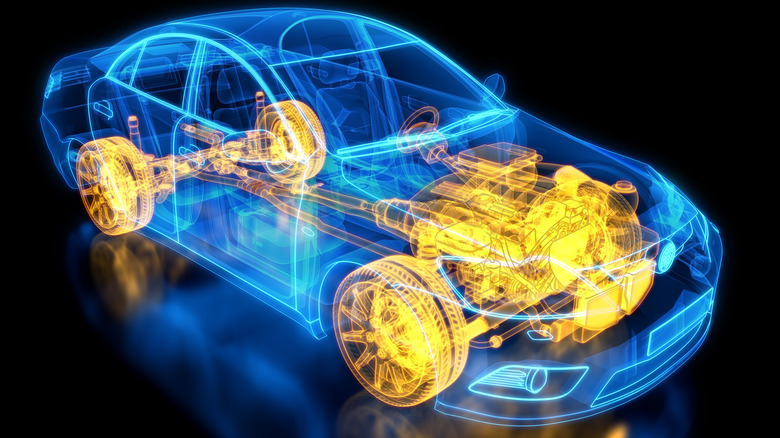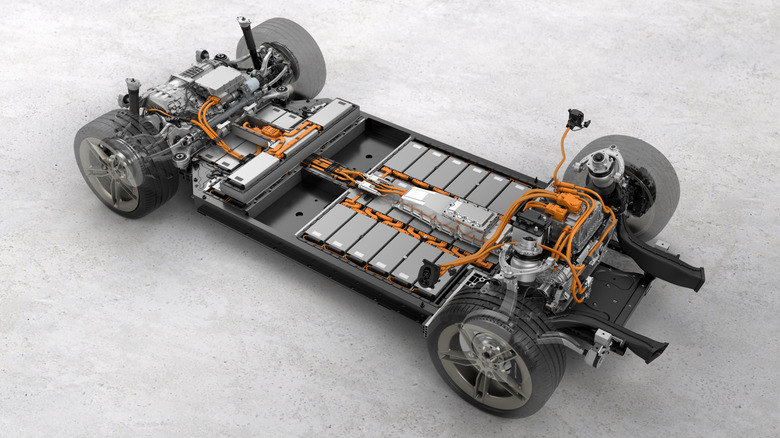Why Car Axles Are More Complicated Than You Think (And Why One Day We Might Not Even Need Them)
For the most part, while their functions are deceptively complex, we're all familiar with a typical car axle. Being the method by which most cars mount their wheels, axles represent one of the most important components on just about any vehicle. In its most simplest form, an axle is a shaft which mounts at least one wheel on either end. The world's first axles appeared on humble carts and chariots, and for thousands of years they remained the same — virtually nothing more complicated than a straight shaft with wheels attached.
That is, until those wheels needed to be steered, and then needed to be driven. This necessitated the development of articulated functionality — suddenly, the wheels had to turn in another axis, and accept power from an on-board engine as well. This is where things get really complicated, and we'll discuss how both of these tasks are accomplished. However, axles as we know them today might not always be around in mainstream usage as well.
In short, it's largely due to the widespread use of powerful electric motors, which negate many drawbacks of the traditional auto axle. Such drawbacks include the working forces associated with things like differentials, driveshafts and the like, as well as the space these components utilize. Undoubtedly, these advanced electric systems will also undergo their own technological innovations, just like the traditional axles we have today. Let's explore the details of this near-universal means of power transfer common to most vehicles you see on the road, beginning with the basics and working up from there.
Components and terminology of the common car axle
First, let's discuss the basic terminology of what makes up a car's axle. Starting with the axle shaft itself, which in principle, is just a long metal rod. This rod is generally contained within a housing, which is then mounted to a car's suspension. On a solid axle, there is only a single housing with two wheel hubs on either side, the most basic form of axle. If that axle is driven, then you'll need a way to turn it via the differential. A differential (or "diff") looks like a big fist on the axle shaft, housing a set of gears which do a number of things crucial to allowing an axle to receive power, which we'll discuss later.
As for how to get a wheel to steer, that itself is another challenge because you're now introducing a new axis of rotation. The elements associated with a modern steering system vary from car to car, but most utilize a mechanism known as rack-and-pinion steering. In its most basic format, the steering wheel is connected to a gear which is mounted to its own shaft connected to the wheels — turning the wheel turns the gear, which then moves this shaft from side to side, pulling each wheel with it.
For a visual explanation of how this works, this video lays it out simply. Power steering replaces many of these components with pressurized hydraulic lines, providing a consistent, smooth steering input. Some vehicles utilize a concept known as steer-by-wire which eliminates many of these parts, such as the Cybertruck. But for the most part, the basic rack-and-pinion setup remains by far the most commonly used steering method.
Connecting the axle and the engine
Most commonly, engines transmit power to the axle through two primary means: a driveshaft connected to a differential, or — if the axle is located either within or right beside the transmission — a drive axle. In a drive axle, the transmission and differential feature a common housing called a transaxle. This transaxle then has two shafts on either side, namely, the drive axles. Drive axles transmit power from the transmission directly to the wheels.
In rear-engine cars, like a common Volkswagen Beetle, this totally negates the need for a separate driveshaft, since the engine and transmission are placed where the rear wheels are. On a front-engine, rear-drive transaxle-equipped car, however, there must still be a shaft connecting the engine to the transaxle, as is the case in a C5 Corvette.
Now, let's say the transmission is separate from the driven axle itself. A car still requires the power to go from the transmission to the axle, which is more complicated than it sounds. Think about it like this — you need to take a rotational energy which spins the driveshaft around, and turn it 90 degrees so it'll rotate the axle, and thus the wheels. The device responsible for making this turn is the differential, which is required if the wheels are powered. If the wheels are unpowered, like the rear axle on a FWD car, then you can easily just have both rear wheels rotating freely.
Differentials themselves come in many flavors, with the simplest being an open diff that also allows for wheels to rotate freely. Then you have a locked differential, which locks both wheels to the same speed. Limited-slip differentials mean that either wheel won't exceed a certain difference in speed from one another.
Solid axle configurations
Now that we have the power going to the wheels, next is what format the axle itself utilizes — the simplest being a one-piece, solid axle, also called a live axle. In this configuration, you have either just one long shaft connecting both wheels (unpowered), or a differential somewhere in between two axle shafts. The differential's job is to make sure that both halves of the axle are spinning the same direction; if a shaft rotates two connected perpendicular shafts directly, both shafts would end up rotating in opposite directions (left goes up, right goes down in a clockwise rotation).
The defining factor of a solid axle is that it has just one large housing. As such, its robust design often finds use in SUVs and trucks. Suspension is just as straightforward — the main downside being that when a tire goes up on one side, this necessarily affects the tire on the other because both wheels share one single axle housing.
Furthermore, a differential takes up a lot of ground clearance, which can be offset with a portal axle. Portal axles, seen on specialized vehicles like the Mercedes Unimog, feature axles which are raised up higher than the wheel hubs; they connect to the wheels via a gearbox located within the wheel hubs themselves.
These axles are most commonly seen on vehicles like Jeeps and body-on-frame light trucks like pickups. While in the past they were fairly ubiquitous on many body-on-frame sedans and wagons; these days, advances in chassis and suspension technology means that the relatively poor ride quality offered by solid axles rendered them largely obsolete in favor of independently-sprung split axles.
Swing-axle and independent suspension systems
Unlike a solid axle, where when one wheel goes up, the other goes down, a split axle's wheels articulate independently of either side. The earliest popular format of this design dates to the 1960s, such as Ford's "Twin I-Beam" swing axle. First introduced in 1965, this provided the Ford F-series pickup with a primitive true independent front suspension. In this system, each wheel is joined to its own axle, which is connected by a rotating link to the car's frame. Each axle then has a spring mounted further down, allowing both sides to be independently sprung without any direct connection like a live axle.
Most vehicles feature a variation of this system where they have two independent shafts each connected to its own suspension setup, referred to as independent front or rear suspension (IFS and IRS), respectively. If the axle shafts are driven, then the two sides will meet in a differential or transaxle. Regardless, each shaft is then allowed to rotate and pivot up and down on its own, with the point of rotation being a special joint inside the axle shaft itself which then links into the differential housing.
Exempting some heavy-duty applications, most cars with independent suspension feature two axles hooked up to a centrally-placed drive element. These utilize pivoting elements on either side of the shaft housed within axle boots, which then connect to the wheel and differential/transaxle, respectively. The types of suspension such axles utilize are wildly diverse, ranging from basic leaf springs to MacPherson struts to high-end pushrod systems. Similarly, debates continue about which systems are best, and whether you even want independent suspension or standard solid axles to begin with for more specific roles like off-roading.
The problem of parasitic power loss in the drivetrain
The main issue which still plagues the automotive industry remains how to get the engine's peak horsepower to the wheels with as little parasitic loss as possible. Everything connected to the engine requires a certain amount of power to run — accessories, AWD and 4WD devices, the gearbox, and so on. Think about the energy it would take to manually crank all of these as a single unit — that's what your engine must overcome in terms of friction. As such, the actual demonstrated power of the engine often differs from the power delivered to the road; this is the difference between your vehicle's gross horsepower and net horsepower.
An axle and its elements play a crucial role in minimizing this parasitic loss. Because of the physics of leverage, it requires more energy to spin an axle that's a further distance away from its power source. Plus, the differential and/or transmission each contain a number of gears and linkages; these all have their own levels of friction, partially offset by gear oil and other additives.
Basically, the more moving parts a drive system contains in between the engine and the wheels themselves, the more power gets lost between Point A and B. Coupled with all of the accessories mounted to the engine, this power draw can be as drastic as a full third or more. For instance, a 1970 Chevelle SS LS6 produces 450 gross horsepower, though on the dyno that number plummeted to just 288 horsepower to the rear wheels. Powering each wheel itself largely mitigates this problem, so next let's talk about how automakers plan to accomplish this through electric motors and clever engineering.
Electric and mechanically-driven axles and self-powered drive hubs
A drive hub, as opposed to a standard wheel hub, directly connects a wheel to its power source, superseding the need for an axle. In cars, this system is known as an in-wheel motor, and it offers several unique advantages. Firstly, not having any axles means that there's no frictional loss of power. A lack of axle and driveline also frees up all that internal space for other uses, such as cargo room, space for additional batteries or larger motors, or whatever else.
However, such systems are by no means commonplace, with very few vehicles offering true in-wheel motors. Rather, most electric cars these days utilize a single motor with two shafts, similar to a transaxle. Naturally these can double-up — one on the front and one on the rear — for AWD electric vehicles. Each wheel can even be individually powered, negating the need for complex systems like Audi's quattro AWD system.
Some cars even utilize mechanical energy retention elements on otherwise unpowered axles, but generally only in extremely niche roles. For instance, Nissan's 2015 Nismo GT-R LM, which competed in the 2015 24 Hours of Le Mans, utilized a special flywheel which collected energy to then temporarily power the rear wheels during low-speed acceleration. Such systems basically work like a toy car — they "wind up" under braking, and release under acceleration.
Electric motors, however, generally run off batteries and have far longer ranges. These motors either directly drive the wheels, or utilize a gearbox to multiply their torque output, such as the one found in the Porsche Taycan Turbo S. Because there's almost no power loss in comparison to a traditional engine, these systems represent by far the most energy-efficient means of propulsion on cars today.

